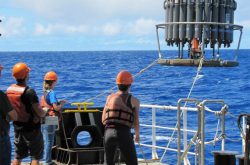
One of the planet’s most active ecosystems is one most people rarely encounter and scientists are only starting to explore. The open ocean contains tiny organisms — phytoplankton — that perform half the photosynthesis on Earth, helping generate oxygen for animals on land.
A study by University of Washington oceanographers, published this summer in Nature Microbiology, looks at how photosynthetic microbes and ocean bacteria use sulfur, a plentiful marine nutrient.
Sulfur is the odorous element that gives beaches their distinctive smell. The new study focused on sulfonates, in which a sulfur atom is connected to three oxygen atoms and a carbon-based molecule. In the ocean, phytoplankton use energy from the sun to create sulfonate molecules. Bacteria then consume the sulfonates to gain nutrients and energy.
Bryndan Durham, then a postdoctoral researcher in oceanography at the UW and now an assistant professor at the University of Florida, drew on the recent genetic studies of soils to learn which microbial pathways are used to process sulfonates in the ocean. The study first focused on 36 marine microbes that the team cultured in the lab, using a UW-developed method to test which organisms produce sulfonates on their own in a lab environment.
The study discovered “some striking similarities between sulfonate pathways in terrestrial and ocean systems,” Durham wrote in a “Behind the Paper” post in Nature Microbiology that discusses the project. In soils, plants typically produce sulfonates. In the oceans most sulfonates are also produced by photosynthetic organisms, in this case by unicellular phytoplankton.
Read more at UW News »
